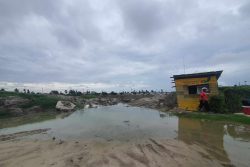On August 11 2021, in the final days of the chaotic retreat from Afghanistan by history’s mightiest military power, a C-17 plane landed at Kabul airport to deliver supplies. Surrounded by Afghans who had breached the airport’s perimeter, the crew decided to immediately take off.
Among those on the tarmac was Fida Mohammad, a 24-year-old dentist who took the opportunity along with another man to hide in the wheel well of the plane in a bid to escape the coming Taliban regime. As the Associated Press reported “as the wheels folded into the body of the plane, the stowaways faced the choice of being crushed to death or letting go and plunging to the ground.” Video footage shows two dots falling from the sky.
“He had once been full of hope, his family said. He had married last year in an extravagant ceremony that cost his family $13,000. His dream of opening a dental clinic in Kabul had become a reality. Then the Taliban seized Kabul, and all the possibilities for his future seemed to disappear.”
The date was exactly one month shy of 20 years since the September 11th 2001 attacks on the World Trade Center and the Pentagon that would spark an all consuming War on Terror and the invasion of Afghanistan and Iraq at the cost of hundreds of thousands of lives and trillions of dollars. On that day, Americans too had fallen from the sky, escaping the smoke and heat of the twin towers. The symmetry of these two events is both poignant and tragic.
Before man could even fly, he dreamt of it. The Greek myth of Icarus has both fascinated and scared humans with its tale of how his Father Deadalus had built wings made from feathers and wax for him to escape the island of Crete, while warning neither to fly too low or too high. Young Icarus, too elated by the thrill of flight, had flown “too close to the sun”, the wax melted and he plunged into the sea. The moment is depicted in Peter Brueghel the Elder’s painting “Landscape with the Fall of Icarus” c1560 that merely shows a pair of legs disappearing beneath the water. If you don’t look carefully you might miss them. In turn this painting inspired a poem by WH Auden “Musee de Beaux Arts” that recognises how the Old Masters “were never wrong” “about suffering”:
“….how everything turns away
Quite leisurely from the disaster; the ploughman may
Have heard the splash, the forsaken cry,
But for him it was not an important failure; the sun shone
As it had to on the white legs disappearing into the green
Water, and the expensive delicate ship that must have seen
Something amazing, a boy falling out of the sky,
Had somewhere to get to and sailed calmly on”
Soon after man figured out how to get airborne (rather than actively fly), there were many such hard landings. In 1785 the first attempt to cross the British Channel by a couple of Frenchmen ended in disaster when their hydrogen balloon exploded after take off.
Later on dirigibles or airships, filled with hydrogen, were developed allowing directional flight rather than reliance on the wind and by the 1920s would offer commercial transatlantic flights taking only a few days.
This era would come to an end with the 1937 Hindenburg disaster when the German airship attempted to land in Lakehurst, New Jersey. Thirty five people in all were killed and the event was one of the first iconic electronic news moments – like 9/11 and the Afghan incident – to be caught on camera including an impassioned but still descriptive commentary by Herbert Morrison that was broadcast nationwide the next day: “It’s burst into flames! It’s burst into flame, and it’s falling! It’s crashing! Watch it! Watch it, folks!…..it’s falling on the mooring mast and all the folks between — oh, this is terrible; this is one of the worst catastrophes in the world. …Oh, the humanity!”
With the development and proliferation of commercial aircraft and flights, came the modern day Icaruses. The Federal Aviation Administration (FAA) documented 113 such attempts on 101 flights between 1947 and 2015 with 86 fatalities.
The first recorded case was a 30-year-old who survived a KLM flight from Lisbon to Natal Brazil in 1947. Rather than the issues Icarus faced from the heat of the sun, it is the cold of the high altitude and the lack of oxygen which invariably make such attempts end in death. A cruising altitude of 35,000 ft and temperatures of minus 50 degrees cause hypothermia while the thin air causes hypoxia. Those stowaways who are still alive can go into such a deep sleep they end up falling out when the plane deploys its landing gear upon arrival. An area of south London in the flight pathway for Heathrow has seen a few such bodies fall to earth. In June 2019 an unidentified stowaway on a Kenya Airways flight landed on the patio of a townhouse.
Such high risk, headline grabbing escapades are thankfully rare but are simply another version of attempts to migrate and are indicative of the desperation many in the developing world feel to escape economic and political hardships. Millions more go overland or by boat in search of better lives. Sadly the attitudes of Western governments to migrants is becoming increasingly harsh even though they refuse to acknowledge their historical roles in creating the societies these migrants come from. UK Home Secretary Suella Braverman recently described the dinghies of migrants landing on the shores of southern England as an “invasion”. The irony is that she is herself the daughter of immigrants from Mauritius and Kenya who would likely not be eligible to enter her homeland under her government’s policy.
Migration will continue as long as the inequalities between the developed and developing worlds persist. Spending more than the .7% of Gross National Income on development aid while genuinely working towards peaceful resolutions to international conflicts makes more effective long term foreign policy and better immigration policy.






